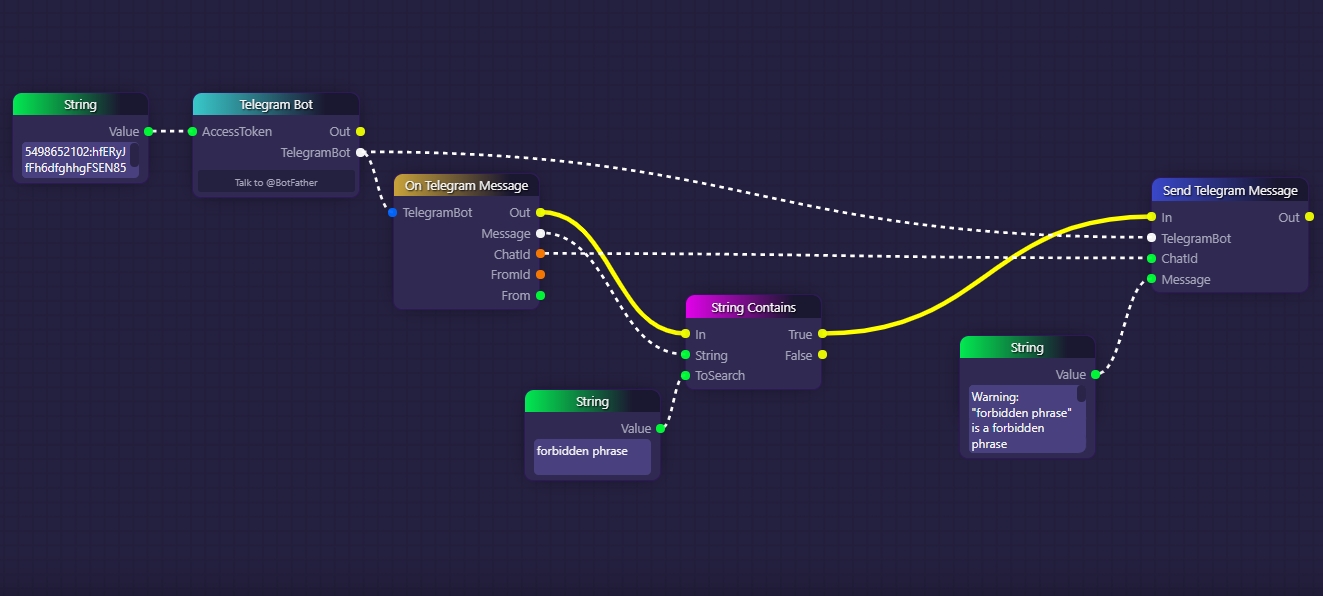String Contains
Perform conditional checks and make decisions based on the presence or absence of certain patterns in a string
The String Contains block in the GraphLinq IDE is a powerful tool designed to determine whether a specific substring exists within a given string. It enables developers to perform conditional checks and make decisions based on the presence or absence of certain patterns in the input strings. This block provides essential functionality for handling and processing text-based data within graphs.
Block Description
The String Contains block belongs to the String category of blocks in the GraphLinq IDE. Its primary purpose is to check if a specified substring is present within a given input string.
Input Parameters
The String Contains block requires two input parameters:
InputString (String Type): This parameter represents the input string within which the presence of the substring will be evaluated.
Substring (String Type): The Substring input is the specific sequence of characters that the block will search for in the InputString.
Output: The output of the String Contains block is a boolean value ("true" or "false") that indicates whether the Substring is found within the InputString. If the Substring is present, the output will be "true"; otherwise, it will be "false."
Example Use Case
Let's explore a practical example to illustrate how the String Contains block can be utilized in a graph:
The graph receives user input through a String block, storing it in the variable "userMessage."
The String Contains block is then used to check if the user's message contains a specific keyword, such as "help" or "support."
Based on the output of the String Contains block, the graph can determine whether the user's message requires additional assistance or action.
If the output is "true," indicating that the keyword is present in the user's message, the graph can execute specific blocks to provide the required support or information.
In this example, the String Contains block enables the graph to perform conditional checks on the user's input, allowing developers to create interactive and responsive applications that respond to specific keywords or patterns in user messages.
The String Contains block is an essential component in the GraphLinq IDE for handling and processing text data within graphs. Its capability to check for the existence of substrings provides valuable functionalities for conditional branching and decision-making. By leveraging the String Contains block, developers can create dynamic and intelligent graphs that respond appropriately to different patterns in input strings, enhancing the overall functionality and interactivity of their applications.
More Information
The String Contains block is a versatile component in the GraphLinq IDE used to check if a specific substring exists within a given string. It is invaluable for performing conditional checks and making decisions based on the presence or absence of certain patterns in the input strings.
Usage:
The String Contains block takes two string inputs: the main string and the substring. It then evaluates whether the substring is a part of the main string. If the substring is found within the main string, the block outputs a boolean value "true"; otherwise, it outputs "false."
Example:
Suppose we have a string "GraphLinq is awesome," and we want to check if it contains the substring "awesome." We can use the "String Contains" block with the main string as "GraphLinq is awesome" and the substring as "awesome." The block will return "true" because the substring "awesome" is present in the main string.
Advantages:
The "String Contains" block empowers developers to create conditional logic within their graphs. By checking for specific substrings, graphs can dynamically adapt their behavior based on user input or real-time data, making applications more interactive and responsive.
Summary:
The "String Contains" block in the GraphLinq IDE provides a straightforward way to determine if a particular substring exists within a given string. It enables the implementation of conditional checks and dynamic decision-making in graphs, enhancing the graph's ability to respond intelligently to different scenarios.
Full Example
String Contains blocks make it possible to search through a string to see if it contains some other string. This allows us to sift through text from whatever sources and check for certain words or phrases.
In the following example, we check every message that a Telegram bot hears to see if it contains the string "forbidden phrase". If it hears "forbidden phrase", it sends a warning message in the same Telegram channel that it heard the message in.

In this next example, we listen to tweets from some particular Twitter account, and if they contain "Bitcoin" or "btc", a message is printed to the logs with a Print block.

In the above example, we use a String Contains block to check every tweet made by FamousTwitterHandle. We first check to see if the tweet contains "Bitcoin". If it doesn't then we use a second String Contains block to see if it contains "btc". Note that String Contains blocks are not case sensitive, so this graph would also detect "bitcoin" and "BTC".
If the String Contains blocks detect either "Bitcoin" or "btc" (or "bitcoin" or "BTC"), then we print a message about it into the logs. Note that we could do something more interesting after detecting a phrase in a tweet, like send a message from a Discord bot, send ourselves an email or phone notification, or even deploy a buy or sell order on Binance.
Last updated
